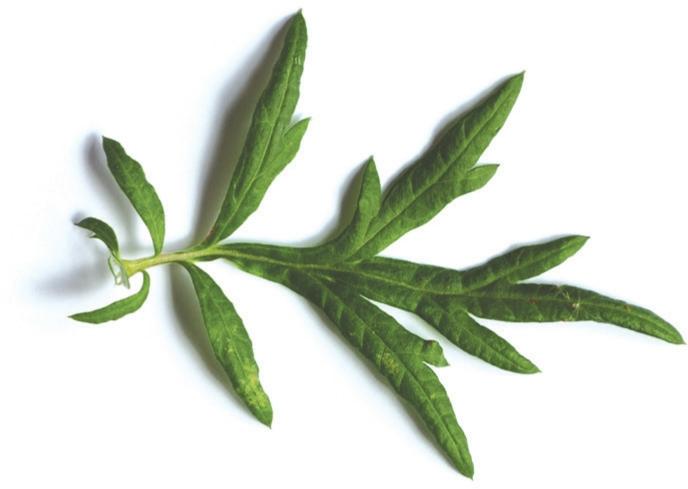Mugwort is a stately, self-assured perennial, a tall summer presence at two or even three metres high, found in country and town alike. It is, however, far more than a roadside curiosity.
It is an ancient herb of healing, magic and divination throughout the world, a protector of women and travellers, renowned for its value in feminine disorders, and as a strong warming tonic. Mugwort was used in making ale in Europe before hops.

Asteraceae (Compositae) Daisy family
Description: A tall, slightly aromatic perennial with silvery flower spikes, growing to 1–3m. Leaves are pinnate, dark green and smooth above, silver beneath.
Habitat: Waysides, roadsides, waste ground.
Distribution: Found in most of the British Isles except south-west Ireland and the hills of northern England and Scotland. Found across Europe to Asia and North America.
Related species: Chinese mugwort (A. verlotiorum) is well established around London. Wormwood (A. absinthium) grows in parts of England and Wales. Hoary mugwort (A. stelleriana) is found on some coastal dunes, and sea wormwood (Seriphidium maritimum) on dry edges of saltmarshes and sea-walls. There are a few other species with local distribution.
Worldwide, there are hundreds of species of Artemisia, including tarragon and North American sagebrush.
Parts used: Flowering tops and leaves.
The first clue to mugwort’s significance might be found in its scientific name. Artemis was the Greek moon goddess and patron of women, especially at critical phases of their life cycle – at the onset of menstruation, in childbirth and at menopause.
Vulgaris can mean ‘of the people’, or, a little more condescendingly, ‘common’ and by extension ‘abundant’. A frequently found herb that is available to assist women everywhere for critical times could hardly have a more apt name than Artemesia vulgaris.
Such qualities have been recognised far and wide. Mugwort has been called ‘the mother of herbs’ in several cultures. Ayurvedic practitioners in India use it in treating female reproductive disorders; a related species has the same function in southern Africa, and it has long been known in China for regulating the menses and ‘calming a restless foetus’.
Culpeper placed it under the power of Venus; the Pennsylvania Dutch knew mugwort as Aldy Fraw, or ‘old woman’, underlining ancestral wisdom and feminine qualities; and a contemporary western herbalist calls it ‘the feminine remedy par excellence’.
A saying from the North of England and Scotland underlines the traditional value of female spring tonics: ‘If nettles were used in March and muggings [mugwort] in May, many a bra’ lass wouldna turn t’clay.’
Another dimension to mugwort’s popularity is its capacity to influence dreams, a powerful attribute in traditional cultures. A bundle of leaves and flower heads placed under the pillow, or made into a ‘dream pillow’, can calm sleep and protect from nightmares. It might also yield lucid dreams in certain people. In this sense mugwort is shamanistic, underlining its use in divination.

A close-up of mugwort buds and flowers
It is a continuing tradition of a number of Native American groups to burn bundles of cured and dried sagebrush (A. tridentata), a close relative of mugwort, as ‘smudge sticks’. These bundles burn slowly, like an incense stick, producing smoke that is used to cleanse the energy of houses and sacred spaces (see page 109).
Burning a mugwort smudge stick certainly worked in calming the frantic energy when our teenage son had a big boozy party at our home. It also helps shift old, stuck energy – we found ourselves therapeutically clearing out the garden sheds next morning.
Use mugwort for…
Burning mugwort can dispel midges and other summer biting insects, a quality sometimes suggested as a source of its name (Old Saxon muggia wort or midge plant). A case is made too for the Saxon moughte, a moth or maggot, referring to mugwort’s ability to keep away moths from clothes.
The thirteenth-century Physicians of Myddfai in central Wales knew mugwort as a useful insecticide: ‘to destroy flies, let the mugwort be put in a place where they are frequent and they will die’.
Our own favourite explanation for the name mugwort is its former use as a herbal flavouring for ale. It could have literally been the ‘mugwort’, the measure of a brew, from a time before hops came in during and after the Middle Ages, and the Briton’s drink gradually switched from ale to beer. Mugwort, along with yarrow, myrtle and heather, was a common ingredient in gruit or grut, a strong herbal ale. This is currently enjoying something of a revival in the modern microbrewery movement.
An infusion of mugwort in cold drinks, whether beer or fruit in origin, adds a sharp summer tang and aromatic smell that you can enjoy in safety. These make for a more homely and less risky prospect than absinthe, the liqueur derived from the closely related wormwood (A. absinthium). As the world knows, this was the tipple of the fin de siècle French literary and art world. Containing a toxic essential oil that mugwort lacks, absinthe could be fatally addictive. It was banned in Europe for most of the twentieth century.
Mugwort, it will be clear by now, has had something of a dangerous past, at the hazy margin of sacred and secular culture – indeed, from a time when there was no distinction made between the two.
American herbalist Maida Silverman believes that ‘Folklore and superstition are bound up with the Mugwort plant to an extent hardly matched by any other herb.’ She instances as the oldest superstition the first-century AD Roman naturalist Pliny, who recommended that travellers carry mugwort as an amulet for psychic protection. This belief lasted through and beyond the Middle Ages, only to be roundly condemned by the ‘rational’ herbalists like Gerard (1597) and Parkinson (1640).
Mugwort was a key Anglo-Saxon sacred herb: the Leech Book of Bald from tenth-century Wessex extols it as ‘eldest of worts / Thou has might for three / And against thirty’. Again the great age and protective power of mugwort are emphasised.
In medieval times mugwort passed from the patronage of the pagan Artemis to the Christian care of St John the Baptist, who was said to have carried it into the wilderness to ward off evil. From this came ‘St John’s girdle’ and the wearing of a mugwort garland on St John’s day, 24 June, while dancing around the traditional fire. Throwing the garland into the fire would ensure protection for the following year, another pagan survival that so annoyed John Parkinson. He would be aghast to learn that a mugwort ceremony still marks midsummer in the Isle of Man (see box on page 108).
Wider afield, mugwort was known to Chinese medicine as a house protector and in the practice of moxibustion. This is an integral part of acupuncture, and many readers will have experienced the cone of dried mugwort leaves, moxa, being placed on the skin and burnt to stimulate an acupuncture point. The particular application of moxa is for treating abdominal pain from the cold, and it is mugwort’s warming quality that makes it effective.
One other aspect of mugwort and fire can be mentioned briefly. Other names for the plant, gypsy’s tobacco and muggar, record its persistent use as a smoking leaf inside strips of newspaper.
Burnt or not, mugwort has valuable warming qualities. It is known herbally as an aromatic bitter, which warms the digestion and stimulates a sluggish liver. It encourages the secretion of digestive juices and its oils help eliminate gas and griping.

Herbalists value mugwort as a general calmer of the nervous system, helping to relieve stress and nervous tension. Mugwort pillows can help soothe disturbed sleep as well as promote dreaming. In general the plant has an uplifting effect on mood and is valuable in treating forms of mild depression linked with digestive weakness.
Taken as a tincture, mugwort can help in normalising menstrual flow, and is particularly useful for bringing on delayed or suppressed periods where they have been absent for some time. It is a good herb for young women at puberty, helping to establish a regular cycle. Because it stimulates the uterus, it is not normally used in western herbalism during pregnancy, though in China it is an accepted treatment in preventing miscarriage.
Mugwort has some antimalarial activity, though much milder than Sweet Annie (Artemisia annua). It is also effective against threadworms and roundworms, like its stronger relative wormwood, and is an effective wash for treating fungal infections.
Manx mugwort magic
Mugwort is the symbolic plant of the Isle of Man and sprigs of it are worn on Manx national day, 5 July. This is St John’s day in the old Julian calendar (it has been 24 June in England and Scotland since 1752, but the old date is kept on Man). On St John’s eve mugwort would be gathered and made into wreaths to be worn by cattle and men alike. Hedge and gorse fires were lit and cattle forced through while men and boys jumped over the flames. This combination of mugwort and fire would protect beast and people from evil spirits for the coming year. The next day was then safe for the many civic ceremonies of Midsummer Court, including the promulgation of laws from Tynwald Hill. As an invited guest, even Queen Elizabeth II on her visit in 2003 duly wore her spray of mugwort or bollan bane (white herb), as it is known locally.
Harvesting mugwort
Pick mugwort in summer, collecting the flower spikes when they are flowering or just before the flowers open when the buds are still silvery. The leaves can be collected too.
Mugwort tincture
Because mugwort becomes more aromatic as it dries, the tincture is best made with dried mugwort, although you can use fresh. Fill a jar with mugwort, then top up with vodka, shaking it to remove air bubbles. Put the jar in a cool dark place for 2 to 4 weeks, then strain and bottle.
Dose: 1–4ml, three times a day.
Mugwort punch
Pour a cupful of red wine into a saucepan.
Add a stick of cinnamon, 5 cloves and a handful of mugwort tops.
Bring to a boil, then turn down the heat and simmer gently with a lid on for half an hour.
Strain out the herbs and spices. Sweeten with honey. It can be taken hot or cold before a meal to stimulate appetite and digestion. Can be drunk fresh or kept in a bottle for several weeks.
Mugwort pillow
Pick mugwort flowers and leaves and dry them. Make a small bag for the pillow out of cloth, leaving one end open – any size you like, but 20cm x 30cm works well. Fill the bag loosely with the dried mugwort so that the finished pillow will be 1 or 2cm thick, then stitch up the open end. Place this under your regular pillow. Smaller cloth bags of mugwort can be stored among clothing to discourage clothes moths.
Mugwort smudge stick
Pick the silvery top 20cm or so of mugwort when the flowers are in bud or first open. Leave them in a cool airy place to dry for a few days. Before they dry completely, and while they are still flexible, make small bundles up to about 3cm thick, with the stem ends together. Starting at the stem end, wind a piece of cotton thread in a spiral around the bundle to the end and then back again, tying off securely. Leave the bundles to dry completely.
To use, hold the smudge stick by the stem end and light the other end with a match. You may need to blow on it at first to keep it burning. Wave the stick around with a circular motion as you move through a room or around a person – the movement helps keep the stick burning as well as spreading the smoke through the air.

The underside of a mugwort leaf is covered with silvery, downy hairs.


Mullein.
